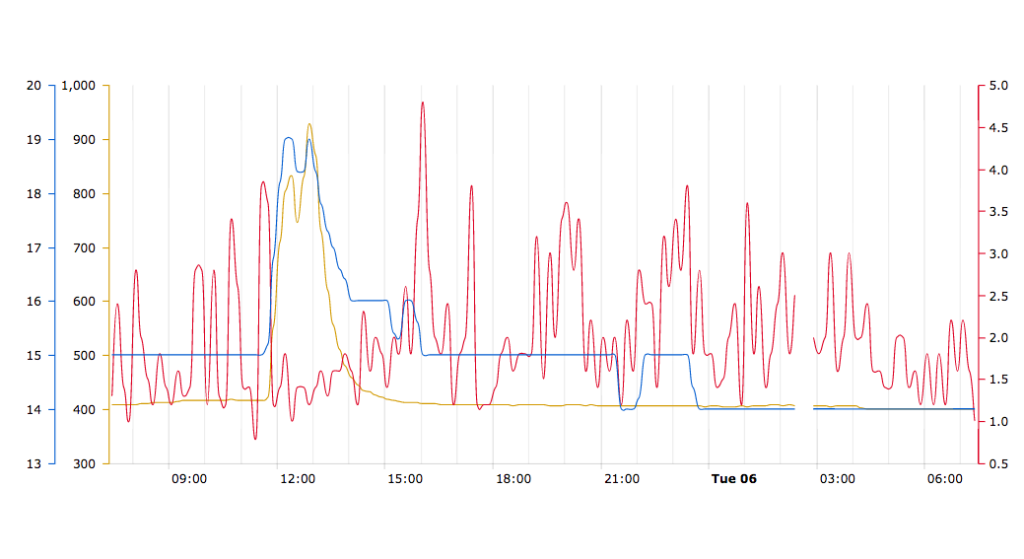12.2.2018 - Johannes Puro - Indoor air

Usually new companies have to create their customer base from scratch but sometimes it happens that the market is already there, waiting for the right service provider to show up.
This was the case with SmartWatcher, a company producing indoor air measurement equipment.
– It all happened a bit coincidentally as our owner consulted a global property damage management company in other business matter. For some reason the discussion turned to indoor air quality and the customer told about a site they had visited nine times to measure the air quality, but nothing was found even though it was obvious that something was wrong, starts Pauli Tarna, the CEO of SmartWatcher Ltd.
General problem is that when conducting traditional indoor air quality measurements, it is possible to get data only for the exact time the measurement is done which is usually not enough.
– It has been proved that the quality of indoor air varies a lot during the day depending on different factors like the use of the building, outside air conditions and operation of the ventilation.
– What the customer actually needed was a solution giving real-time information about the conditions in their sites, he continues.
The conversation initiated the development of SmartWatcher’s monitoring system. The process was completed together with the said customer and VTT Technical Research Centre of Finland.

Pauli Tarna stresses that good quality indoor air can improve the ability to learn and concentrate, but it also reduces costs related to health issues.
The SmartWatcher service consists of two elements, a monitoring unit monitoring the air quality and a cloud based service presenting the results in a visual interface. The monitoring unit called the Multisensor constantly monitors temperature, relative humidity, level of carbon dioxide, small particles and volatile organic compounds (VOC).
– The service is pretty simple. Multisensor needs no specific installation, it just needs to be powered up and the operation starts automatically. The measured data is sent to cloud via 3G or our own proprietary LoRa-network, and after analysis the results can be seen in real time. It is also possible to program alarms and reminders to the service to warn about changing conditions.
– In addition to our Multisensor we have a wireless sensor to monitor the pressure difference in the building. Information about pressure differences can be vital when checking for example how the ventilation works, Tarna explains.
With SmartWatcher service one can get exact information about the situation and take needed actions immediately. According to Tarna, this not only minimizes the exposure to poor air but lessens the number of sick days, thus reducing costs related to health issues.
We are spending up to 90% of our time indoors so poor air quality can affect all of us at some point. The problem is that we are not aware if we are breathing unhealthy air until we get symptoms.
In many cases this could be too late.
– The quality of indoor air inside offices, schools, and other workplaces is important not only for workers’ comfort but also for their health, Pauli Tarna states and refers to findings on variety of health issues caused by bad indoor air.
Poor indoor air quality (IAQ) has been tied to symptoms like headaches, fatigue, difficulty concentrating, and irritation of the eyes, nose, throat and lungs. Some diseases have also been linked to specific air contaminants or indoor environments, like asthma and damp indoor environments.
“Mold and microbes are present only in 5 to 10 % of sites with indoor air problems.”
Tarna tells that people are often most afraid of moisture damages, but according to indoor air experts, mold and microbes are present only in 5 to 10 % of sites with indoor air problems.
– Indoor air quality can be compromised due to so many reasons such as poor ventilation, problems controlling temperature, high or low humidity, recent remodeling or other activities in or near the building that may affect the freshness of air.
One of SmartWatcher’s biggest customer groups are schools and kindergartens. Typically problems arise when poor ventilation causes the CO2 levels rise too high. When there is not enough oxygen in the air, people feel tired and have difficulties to concentrate.
– Poor indoor air is one major cause reducing ability for learning. We have managed to improve air in classrooms just by adjusting the ventilation and eliminating VOCs.
Tarna reminds that also too low or too high temperature makes us feel uncomfortable affecting the ability to concentrate and learn.
– For example in Finland the air is very dry during the winter season. When mucous membranes get too dry, it is easier for small particles to get into the bloodstream making us ill.

The SmartWatcher service constantly monitors the indoor environment and warns of changes.
Especially vulnerable are people already suffering from an illness or trauma. Recent findings in ageing hospital buildings have brought health care centers and University hospitals to clients for SmartWatcher. Their service is already in daily use in several facilities around Finland.
– For example the Women’s Hospital in Helsinki is a major maternity hospital in Finland with around 10 000 annual births. They are one of our biggest clients and fully monitored with our service in order to catch potential threats of the indoor air immediately.
According to Pauli Tarna, the market for good indoor air solution is wide open not only in Finland but in all corners of the world, for many reasons. Indoor air quality problems are ranging from fumes and gases of cooking to the heavy pollution of industrialized countries.
– Particle pollution is found everywhere. In the Middle East small particles are a significant problem due to sandstorms, whereas in big Asian cities the traffic is responsible for lowering the quality of air. The forest fires of Indonesia tend to affect the living conditions in Singapore due to a heavy haze that can last for weeks, Tarna describes.
In the northern and southern parts of the globe central heating during the winter season can lower the relative humidity to harmful levels. Also damage to buildings due to too high humidity is common in hot and humid countries.
If the causes may vary, so does the the level of knowledge in the air quality matters.
– In central Europe people are only starting to learn about the combined effects of warm and moist air. For instance in England the weather is damp which exposes buildings to moisture damages. Mold is hard to localize – sensors may catch the spores and gases it produces in the air but only indirectly, he tells.

– In the end, seeing is believing. The importance of our solution is that we can show people what is going on in their office space or in their children’s school in real time so they don’t have to speculate.
– Most of the symptoms caused by poor indoor air are pretty vague and in different people they are also manifested differently. When we can point to the source of the problem and show people data before and after repairs, they can actually stop worrying about every flu that comes along, he explains.
“When we can point to the source of the problem and show people data before and after repairs, they can stop worrying.”
The SmartWatcher service solution has already established a good status in Finland, but they are looking to enter global markets. What made the success possible?
– Our service was created to fulfill a customer need, and customers are very much involved in the development. For us it is extremely important to look in the same direction as our clients and for that we always welcome feedback – even critical thoughts and suggestions, Tarna concludes.
See SmartWatcher’s webpages
Related articles:
Interviewee
Author

Leave comment - comments(0)